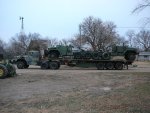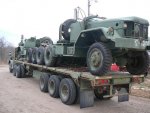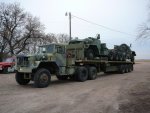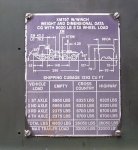The fifth wheels can hold a much bigger load than the truck is designed for. Commonly the maker is Holland Hitches. If you find any kind of makers label on it, you can contact them. Normaly they give you the informations about the fifth wheel.
However, the trucks are not made for these weights. Check for tire load capacyty. You will be shocked!
First the horse powers are to low for something more than 28 to 30 tons gross combination weight (five ton class). Also the power trains are not made for more.
Second the fifth wheel load maximum is the difference between the curb weight (the real one, not the theoretical Army weight) and the declared gross weight of the tractor. But only, if the fifth wheel is at the theoretically best location. Normally the location is in a position that overloads the front axle. Only calculation can help you to find out the real maximum load.
If you overload your truck one or two times by one or two tons, it will not really suffer from that. But every overload shortens the livetime by several 1000 miles, depending on the roads you use. Mountains kill, plains not so much!
If you have a truck desinged to hawl tanks even with low hose powers the truck will serve you very long, for it is almost impossible for you to overload it with your loads.
The relatively new Freightliners are trucks, line pull 120000 lbs, which means a gross rig weight below the legal 40 metric tons in Europe, for the semis awailable at the US Army in Europe do not cover the neccessary gross weight. Theoretically they are good for 54 metric tons. This will not help with semis with 20 to 25 tons permissable weight. And their power train is not really the state of the art, even 10 or 15 years ago. OK, it is automatic, but not enough ratio steps.
Wolf





